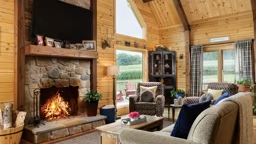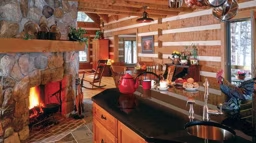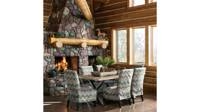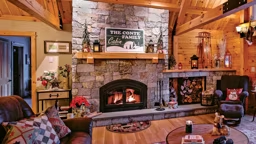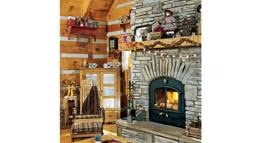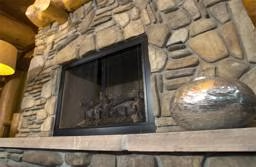One of the “essentials” of a log home is the classic fireplace and chimney, the towering edifice that usually anchors the great room. While a natural stone structure is still the primary choice for log-home owners, there are other fireplace options to consider.
The classic is built on site by a mason and is constructed to draw air well. Its outer surface can never be too hot to ignite the home wall and ceiling construction materials that touch it. A fireplace featuring natural stone also requires a substantial footing, one that descends as deep into the ground as the foundation for the house walls themselves. Put these all together — foundation, masonry materials, local skilled labor — and you can come up with a hefty bill, up to $10,000 or more (we’ve heard of some that cost more than $50,000).
The next most popular option features man-made rock. They’re made with a combination of lightweight rock bits, pigments, and cement. They can be made to look like almost any kind of natural stone.
There are a number of advantages to man-made (also called synthetic or cultured stone) hearths. Because of the lighter weight of the cultured stone, they usually don’t need additional footing but can be built on the subfloor of the home. Generally, the man-made rock is a veneer set into a mortar backing erected on metal lathing over a wooden framework (other backings can be cinderblock or even rigid foam). Smoke and exhaust gases from the firebox are routed up through the roof in a metal flue set off from the synthetic-rock chimney by noncombustible spacers.
All of this makes for a hearth and chimney that are extremely difficult to distinguish from those made from natural stone, and at less cost. Although the synthetic stone itself can cost twice as much as natural stone, a hearth and chimney of synthetic stone can be built at a total cost of 25 to 40 percent less than one of natural stone, owing to less labor and footing cost.
Also available are wood-burning hearths without a visible chimney, which are often good choices in dens, libraries, and bedrooms. These fireplaces expel smoke through flues hidden behind the wall. These models tend to cost several thousand dollars.
Gas or propane fireplaces, which can be operated with the flick of a switch, are gaining in popularity because of their convenience. Like fireplaces of cultured stone, they’re lightweight and don’t require additional foundation work. The smell of smoke doesn’t permeate the room, and the difficulty and expense of acquiring wood to burn is removed. And they can be placed in locations awkward or impossible for wood-burning fireplaces. These run from $1,500 to $3,000 uninstalled.
Freestanding wood-burning and gas stoves remain popular, particularly for cabins and hunting retreats. The “classic” is the pot-bellied or Franklin stove made of metal, which burns wood and expels smoke through a round metal flue. These types can stand anywhere in a home as long as a flue can be routed up and out; many times you’ll see them in a kitchen or basement den. The main advantage of a stove is that more heat is released to the surrounding air of the room.
Another idea is a pellet stove. The convenience factor for pellet stoves comes from the extra step of having your fuel wood pre-processed into small, easily managed bits. Pellet stoves generate a very intense fire, and ash remaining after a burn is therefore minimal. They’re also more controllable in terms of managing temperature.
Freestanding wood, gas, and pellet stoves also offer the benefits of being direct-vent heat sources.
Today, more than ever, you have plenty of ideas to consider for your log-home fireplace.
Fireplace options
Choices abound when it comes time to plan that massive great room centerpiece.




